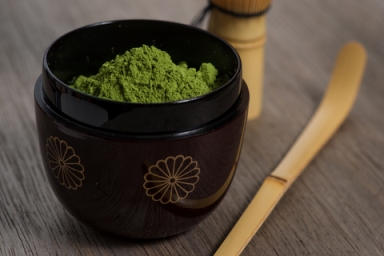 For generations,he Japanese have practiced a ritual of seamless tranquility and mindfulness: The chanoyu or formal preparation of tea.
For generations,he Japanese have practiced a ritual of seamless tranquility and mindfulness: The chanoyu or formal preparation of tea.
The Japanese Tea Ceremony requires focusing all one’s attention on the preparation and serving of tea. Every aspect of the ritual is choreographed, from the preparation of the utensils to the exiting bow. The tea must be of a certain type. It must be accompanied by the right foods. Even the furnishings of the room are specified.
A full description of the ceremony and the philosophy behind it would take volumes–devotees spend lifetimes perfecting their skills—but for a quick visual introduction to the Tea Ceremony, check out this film on YouTube and this one.
The practice of chanoyu (literally “hot water for tea”) is rather alien to us Westerners, with our hurry, our worry, and our urge to fight our way through things. It is precisely because it is so different from our usual way of doing things that I think we writers can learn from chanoyu. Even a superficial understanding of the Tea Ceremony can yield lessons we can apply to our writing. Here are three:
Prepare well
Preparation for the tea ceremony includes sending proper invitations, cleaning the teahouse and the garden surrounding it, and selecting the utensils. The foods to be served with the tea are prepared ahead of time. At the ceremony itself, the opening of the teahouse door, the greeting of the guests, and the cleaning of the utensils are all part of proper preparation.
What if we writers brought just a tiny bit of the same type of mindful preparation to our writing? Many successful writers do prepare before they sit down to write. William Wordsworth, Henry james, Virginia Woolf, and Charles Dickens all walked—Wordsworth is said to have walked for miles before writing. Other writers meditate, move, or clean. Novelist Susan Taylor Chehak, in an interview with Susan K. Perry, said she prepares for writing by “Making sure that everybody’s cared for and everybody’s full and set and nobody needs me.” Another young author writes: “ I would go into the study and sit in the orange chair and light a candle and sit and stare, in perfect silence. I could always count on this to bring on the state of mind I needed…”
However we do it, taking time not merely to prepare, but to do so with intention and thoughtfulness can set the stage for writing well, with focus and clarity.
Play Attention to Your Tools
Frankly, I hardly pay any attention to the tools I write with. I use whatever is at hand—a laptop, a tablet, a table napkin and crayon. But last summer, when I decided to keep a pen-and-paper journal of my sabbatical year, I found myself dwelling on what journal to get. I spent time considering different styles of journals, paying attention to the color of the cover, the texture of the paper, the heft of the journal in my hand.
Taking time to consider what I would be writing with gave the task of keeping my journal more significance, more weight.
I became even more aware of the importance of tools in writing when I taught a course titled Writing for the Digital Age last year. Early in the course, I asked my students how many of them had ever typed on a manual typewriter. For those who had (there were more than I expected), I asked what the experience was like. I was expecting them to say it was dreadful—cumbersome, laborious, with no easy way to correct mistakes. Instead, almost all of them said the experience had been transformative. “I found myself thinking about every word before I typed it,” one student said. “I had to consider seriously and deeply what to say—and that made my writing much stronger.”
Buddhist writer Natalie Goldberg agrees that the tools we write with are essential—she tells writers to pick out a good notebook and always write with a pen. But I don’t think the specific tool matters as much as taking the time to think about your tools. Consider what works best for you. Select tools that feel right. Pay attention to them with the kind of respectful gratitude the practioner of chanoyu uses.
Work Slowly
Dozens—perhaps hundreds—of blog posts have been written about how to write more in less time. Productivity is a word writers throw around a lot. With events like NaNoWriMo telling us we can write novels in a month, and books on the market like Writing Fast: How to Write Anything with Lightning Speed, it’s little wonder we have so much trouble thinking of writing with a thoughtful, unhurried pace.
Yet, there is something to be said for slowing down, for writing with deliberation, for weighing words before they’re committed to the page. “Slow writing is about taking the time to craft the writing so it is good company,” writes Julia Alvarez. “Craft takes time to acquire and time to execute.” Author Ollin Morales agrees. “I would rather work slowly to make a great dream come true than work quickly to make a mediocre come to pass,” he writes on CreativePenn.com. “I’d rather honor the long-term purpose behind my work than sacrifice that purpose for home short-term gain.”
The chanoyu is not about worship, as religious ritual is. It is not about showing how much more accomplished you are than other practitioners or competing to see who provides the best tea. It is simply about “preparing a bowl of tea from one’s heart.” It is a way of honoring the process of making tea.
In the same way, we writers, by learning a few lessons from the tea ceremony, can honor the process of writing and, as we do, bring increased awareness and mindfulness to our writing and our writing lives.
Photo credit: Jannelainea | Dreamstime.com – Japanese Tea Ceremony Setting On Wooden Bench. Photo